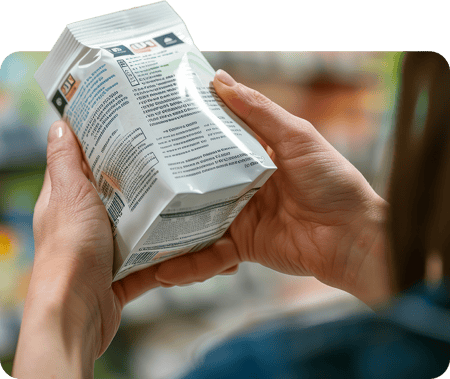What is the
GS1 GDSN?
The GS1 "Global Data Synchronisation Network" is the largest network for the exchange of product information worldwide. Participation in the GS1 GDSN gives manufacturers and retailers access to the proven GS1 standards and procedures. This means that with every new business relationship, they immediately know which information should be transferred in which format and in which way - without lengthy negotiations.

Not-for-Profit-Organisationen
von der GS1
eingeführt
Datenpools
weltweit
Attribute

GS1 - "Global Standards 1"
GS1 is a global association of currently 116 not-for-profit organizations in which manufacturers and retailers have joined forces to develop, negotiate and maintain globally applicable standards for cross-company processes.
GS1 GDSN data pools
The GS1 GDSN was introduced by GS1 in 2004. This global, Internet-based network consists of around 50 so-called data pools through which companies exchange their product information using the GS1 standards.

How exactly does the GS1 GDSN work?

How do the products get onto the shelves of the retailers?
If an FMCG manufacturer wants to sell products through the retail trade and a retailer wants to include this manufacturer's products in its range, then both parties must exchange various product information in order for the business to work: logistics attributes for transport, storage and shelf planning; images, ingredients, allergens and certificates for marketing and compliance and much more.
The GS1 standards
The GS1 data model provides standards for the exchange of this information, which manufacturers and retailers worldwide have agreed upon and which they are continually developing. It contains over 700 attributes, a varying number of which need to be used depending on the respective product or supply chain.

Da kommen die Datenpools des GDSN ins Spiel.
Der Hersteller sucht sich aus den ca. 50 Datenpools weltweit den Datenpool seines Vertrauens (Datenpool A), der den Hersteller in der "Global Registry (GR)" des GS1 GDSN registriert.
Anschließend schickt der Hersteller seine Daten im GS1 Datenformat, einer "Notifikation", zu Datenpool A, der die Daten entsprechend der abgestimmten GDSN Regeln validiert und diese ebenfalls in der Global Registry registriert. Die GS1 GR ist also quasi das Telefonbuch des GS1 GDSN für Hersteller, Händler und Produktdaten.
Der Hersteller entscheidet nun, welchen Händlern er seine Daten zusenden möchte. Dabei kann er wählen, ob er seine Daten "public", d.h. an alle Händler in einem "Zielmarkt" wie z.B. Deutschland oder Österreich, oder "non-public", d.h. nur an bestimmte Händler senden möchte. Dazu sendet er die Publikationsinformationen im GS1 Datenformat an Datenpool A, der diese in seine "Synclist" speichert.
Der Händler wiederum sucht sich ebenfalls einen Datenpool seines Vertrauens (Datenpool B), der diesen ebenfalls in der GS1 GR registriert. Datenpool B kann ein anderer Datenpool sein als Datenpool A, muss aber nicht – Hersteller und Händler können auch denselben Datenpool nutzen.
Der Händler teilt Datenpool B mit, dass er gerne die Daten des Herstellers beziehen würde – er "subskribiert" die Daten des Herstellers, entweder alle Daten des Hersteller, nur bestimmte Produkte, nur bestimmte Warengruppen oder auch die Daten eines ganzen Zielmarkts. Diese "Subskription" schickt Datenpool B an die GS1GR, die in ihrem „Telefonbuch“ nachschlägt, welche Datenpools die Subskriptionen benötigen, und diese an Datenpool A weiterleitet.
Datenpool A aktualisiert seine "Synclist" in der nun sowohl Publikation des Herstellers als auch Subskription des Händlers zusammenkommen. Nur bei seinem solchen "Pub-Sub-Match" sendet Datenpool A die Daten an Datenpool B, welcher diese wiederum weiterleitet. Et voilá, die Daten vom Hersteller sind beim Händler angekommen.
Der Händler kann den Hersteller mit einer "Konfirmation" darüber informieren, dass die Daten erfolgreich bei ihm angekommen sind oder aber, nach weiteren Validierungen, den Hersteller mit einer anderen "Konfirmation" wissen lassen, dass die Qualität der Daten nicht ausreichend ist und somit eine Datenkorrektur anfordern.
Sind die Daten korrigiert, sendet der Hersteller erneut eine "Notifikation" an Datenpool A, der diese aufgrund des bestehenden "Pub-Sub-Matches" direkt an Datenpool B aussteuert, von wo aus sie zum Händler gelangen.

The manufacturer selects the data pool he trusts from around 50 data pools worldwide - data pool A. This pool registers the manufacturer in the Global Registry (GR) of the GS1 GDSN.
The manufacturer then sends its data in the GS1 data format “Notification” to data pool A.
Data pool A validates the data according to the applicable GDSN rules. If the data is valid, it will also be registered in the Global Registry.
The Global Registry is thus something like the "Yellow Pages" of the GS1 GDSN for manufacturers, retailers and product data.
The manufacturer now decides whether he wants to publish his data "public", i.e. to all retailers in a target market such as DE, AT or CH, or "non-public", i.e. only to certain retailers.
He sends this publication information in the GS1 data format "Publication" to data pool A, which stores it in its so-called "synclist".
The retailer, in turn, also looked for a data pool of his trust (data pool B) and was also registered by this pool in the GS1 Global Registry.
Data pool B can be a different data pool than data pool A, but it does not have to be – manufacturers and retailers can also use the same data pool.
The retailer now "subscribes" to data from the GS1 GDSN. To do this, he tells data pool B which data he would like to receive.
He can obtain all data from a target market, all data from a manufacturer, only certain product groups or only certain products from a manufacturer.
Data pool B sends this "subscription" to the GS1 Global Registry. This checks which data pools require the subscription and, in our case, forwards it to data pool A.
Data pool A updates its "synclist", which now includes the manufacturer's publication and the dealer's subscription. There is a so-called "pub-sub match".
Only in case of such a pub-sub match does data pool A send the manufacturer's data to data pool B, which in turn forwards it to the retailer.
Using the GS1 data format "Confirmation", the retailer can either inform the manufacturer that the data has been successfully received, or let him know that the quality of the data is not sufficient and request a data correction.
After any correction, the manufacturer sends the data again via "Notification" to data pool A, which, due to the existing "pub-sub match", forwards it directly to data pool B, from where it in turn goes to the retailer again.
Die Global Registry (GR)
Datenpool A speichert die Daten und registriert den Hersteller in der „Global Registry (GR)“ des GS1 GDSN. Damit ist für alle Datenpools im GS1 GDSN bekannt, dass die Daten vom Hersteller bei Datenpool A liegen. Die GS1 GR ist also quasi das Telefonbuch des GS1 GDSN.
Die "Subskription" - Daten vom Hersteller empfangen
Der Händler wiederum sucht sich ebenfalls einen Datenpool seines Vertrauens (Datenpool B). Er teilt Datenpool B mit, dass er gerne die Daten des Herstellers beziehen würde – er „subskribiert“ die Daten des Herstellers.
Daraufhin prüft Datenpool B in der GS1 Global Registry, bei welchem Datenpool die Daten des Herstellers liegen, und schickt Datenpool A daraufhin die Anforderung für den Bezug der Daten.
Produktinformationen über GS1 Datenpool
Jedes Unternehmen, das Produktinformationen senden oder empfangen muss, kann das GS1 GDSN nutzen, indem es einen von GS1 zertifizierten Datenpool verwendet.
Produktinhalte synchronisieren
Mit Ihrem GS1 GDSN Datenpool können Sie Ihre Produktinhalte mit allen Ihren Handelspartnern synchronisieren, sodass Sie zuverlässige Daten für alle Märkte gleichzeitig eingeben und pflegen können.
GS1-Standard
Die Daten im GDSN folgen den GS1-Standards, die eine weltweit einheitliche Sprache für Produktidentifizierung, Datenerfassung und -austausch bieten.
Erfahren Sie hier:
Sie haben Fragen und möchten Kontakt mit uns aufnehmen? Wir freuen uns auf Sie:
Request a demo with your data or a call with sales
Would you like to know more?
Let us discuss your individual situation in detail and find out how your company can quickly benefit from our experience and solutions.
Send us your request - we will contact you immediately.
Alternatively: Book a meeting directly





